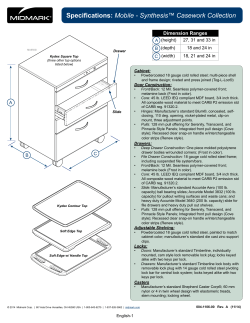
slides as PDF
Lecture 16:
Synchronization
Parallel Computer Architecture and Programming
CMU 15-418/15-618, Spring 2015
Tunes
“Smug”
(Poliça)
“We were feeling pretty good about our chances in the parallel competition…
until we saw what everyone else was doing. Wow those CMU students are impressive.”
- Channy Leaneagh
CMU 15-418/618, Spring 2015
Final project expectations
Frequently asked questions:
Q. Do I need to do something that no one has done before?
A. Nope. However I expect you to take on a challenge where I believe the answer should not be
obvious to you based on what you’ve learned in the course so far.
- Common Scenario: Student: “I am going to run a cat detector on 1M images from Youtube
and parallelize it on a cluster.” Prof. Kayvon: convince why this is hard?
Q. Can my project be a part of something bigger? (e.g., a project from my research lab)
A. Absolutely. As long as you carve off a task that is clearly only being done you.
Q. How much work is expected?
A. Including the proposal period, the project is 6 weeks of the course. We are expecting
proportional effort. (For example, we are expecting at least 2 class assignments worth of work.)
Q. What if I need special equipment?
A. Contact the staff soon. We can help you find resources around CMU:
- The latedays cluster, high-core count machines, GPUs, Oculus Rifts, FPGAs, Tegra K1’s, etc.
CMU 15-418/618, Spring 2015
Final project expectations
▪ Project proposals are due on Thursday April 2 (but you are welcome to submit early
to get feedback… often we have to iterate)
▪ The parallelism competition is on Monday, May 11th during the final exam slot.
-
~20-25 “finalist” projects will present to guest judges during this time
All other projects will presented to course staff later in the day
Final project writeups are due at the end of day on May 11th (no late days)
▪ Your grade is independent of the parallelism competition results
-
It is based on the technical quality of your work, your writeup, and your
presentation
▪ You are absolutely encouraged to design your own project
-
This is supposed to be fun (and challenging)
There is a list of project ideas on the web site to help (we will be adding to it)
CMU 15-418/618, Spring 2015
Today’s topic: efficiently implementing
synchronization primitives
▪ Primitives for ensuring mutual exclusion
-
Locks
Atomic primitives (e.g., atomic_add)
Transactions (later in the course)
▪ Primitives for event signaling
-
Barriers
Flags
CMU 15-418/618, Spring 2015
Three phases of a synchronization event
1. Acquire method
- How a thread attempts to gain access to protected resource
2. Waiting algorithm
- How a thread waits for access to be granted to shared resource
3. Release method
- How thread enables other threads to gain resource when its
work in the synchronized region is complete
CMU 15-418/618, Spring 2015
Busy waiting
▪ Busy waiting (a.k.a. “spinning”)
while (condition X not true) {} logic that assumes X is true ▪ In classes like 15-213 or in operating systems, you have
certainly also talked about synchronization
- You might have been taught busy-waiting is bad: why?
CMU 15-418/618, Spring 2015
“Blocking” synchronization
▪ Idea: if progress cannot be made because a resource cannot
be acquired, it is desirable to free up execution resources for
another thread (preempt the running thread)
if (condition X not true) block until true; // OS scheduler de-‐schedules thread ▪ pthreads mutex example
pthread_mutex_t mutex; pthread_mutex_lock(&mutex);
CMU 15-418/618, Spring 2015
Busy waiting vs. blocking
▪ Busy-waiting can be preferable to blocking if:
-
▪
Scheduling overhead is larger than expected wait time
Processor’s resources not needed for other tasks
-
This is often the case in a parallel program since we usually don’t oversubscribe
a system when running a performance-critical parallel app (e.g., there aren’t
multiple CPU-intensive programs running at the same time)
-
Clarification: be careful to not confuse the above statement with the value of
multi-threading (interleaving execution of multiple threads/tasks to hiding
long latency of memory operations) with other work within the same app.
Examples:
pthread_spinlock_t spin; int lock; pthread_spin_lock(&spin); OSSpinLockLock(&lock); // OSX spin lock
CMU 15-418/618, Spring 2015
Implementing Locks
CMU 15-418/618, Spring 2015
Warm up: a simple, but incorrect, lock
lock:
ld R0, mem[addr] // load word into R0 cmp R0, #0 // if 0, store 1 bnz lock // else, try again st mem[addr], #1 unlock:
st mem[addr], #0 // store 0 to address Problem: data race because LOAD-TEST-STORE is not atomic!
Processor 0 loads address X, observes 0
Processor 1 loads address X, observes 0
Processor 0 writes 1 to address X
Processor 1 writes 1 to address X
CMU 15-418/618, Spring 2015
Test-and-set based lock
Test-and-set instruction:
ts R0, mem[addr] // atomically load mem[addr] into R0 // if mem[addr] is 0 then mem[addr] to 1
lock:
ts R0, mem[addr] // load word into R0 cmp R0, #0 // if 0, lock obtained bnz lock unlock:
st mem[addr], #0 // store 0 to address CMU 15-418/618, Spring 2015
Test-and-set lock: consider coherence traffic
Processor 1
BusRdX
Processor 2
T&S
Update line in cache (set to 1)
Invalidate line
[P1 is holding lock...]
BusRdX
Update line in cache (set to 0)
Invalidate line
= thread has lock
Processor 3
Invalidate line
Invalidate line
T&S
BusRdX
Attempt to update (t&s fails)
Invalidate line
T&S
BusRdX
Attempt to update (t&s fails)
T&S
BusRdX
Attempt to update (t&s fails)
Invalidate line
Invalidate line
T&S
BusRdX
Attempt to update (t&s fails)
Invalidate line
T&S
BusRdX
Update line in cache (set to 1)
CMU 15-418/618, Spring 2015
Test-and-set lock performance
Benchmark: total of N lock/unlock sequences (in aggregate) by P processors
Critical section time removed so graph plots only time acquiring/releasing the lock
Time (us)
Benchmark executes: lock(L); critical-‐section(c) unlock(L);
Bus contention increases amount of
time to transfer lock (lock holder must
wait to acquire bus to release)
Not shown: bus contention also slows
down execution of critical section
Number of processors
Figure credit: Culler, Singh, and Gupta
CMU 15-418/618, Spring 2015
Desirable lock performance characteristics
▪ Low latency
- If lock is free and no other processors are trying to acquire it, a processor should
be able to acquire the lock quickly
▪ Low interconnect traffic
- If all processors are trying to acquire lock at once, they should acquire the lock in
succession with as little traffic as possible
▪ Scalability
- Latency / traffic should scale reasonably with number of processors
▪ Low storage cost
▪ Fairness
- Avoid starvation or substantial unfairness
- One ideal: processors should acquire lock in the order they request access to it
Simple test-and-set lock: low latency (under low contention), high traffic, poor scaling, low storage cost (one int),
no provisions for fairness
CMU 15-418/618, Spring 2015
Test-and-test-and-set lock
void Lock(int* lock) { while (1) { // while another processor has the lock... while (*lock != 0); if (test_and_set(*lock) == 0) // when lock is released, try to acquire it return; } } void Unlock(volatile int* lock) { *lock = 0; }
CMU 15-418/618, Spring 2015
Test-and-test-and-set lock: coherence traffic
Processor 1
Processor 2
Invalidate line
Processor 3
Invalidate line
BusRd
BusRd
[Many reads from local cache]
[Many reads from local cache]
Update line in cache (set to 0)
Invalidate line
Invalidate line
Invalidate line
T&S
BusRdX
Update line in cache (set to 1)
BusRdX
T&S
Update line in cache (set to 1)
[P1 is holding lock...]
BusRdX
Invalidate line
= thread has lock
BusRdX
T&S
Attempt to update (t&s fails)
CMU 15-418/618, Spring 2015
Test-and-test-and-set characteristics
▪ Higher latency than test-and-set in uncontended case
▪
▪
▪
▪
- Must test... then test-and-set
Generates much less interconnect traffic
- One invalidation, per waiting processor, per lock release (O(P) invalidations)
- This is O(P2) interconnect traffic if all processors have the lock cached
- Recall: test-and-set lock generated one invalidation per waiting processor per test
More scalable (due to less traffic)
Storage cost unchanged (one int)
Still no provisions for fairness
CMU 15-418/618, Spring 2015
Test-and-set lock with back off
Upon failure to acquire lock, delay for awhile before retrying
void Lock(volatile int* l) { int amount = 1; while (1) { if (test_and_set(*l) == 0) return; delay(amount); amount *= 2; } }
▪ Same uncontended latency as test-and-set, but potentially higher latency under
▪
▪
▪
▪
contention. Why?
Generates less traffic than test-and-set (not continually attempting to acquire lock)
Improves scalability (due to less traffic)
Storage cost unchanged (still one int for lock)
Exponential back-off can cause severe unfairness
- Newer requesters back off for shorter intervals
CMU 15-418/618, Spring 2015
Ticket lock
Main problem with test-and-set style locks: upon
release, all waiting processors attempt to acquire lock
using test-and-set
struct lock { volatile int next_ticket; volatile int now_serving; }; void Lock(lock* l) { int my_ticket = atomic_increment(&l-‐>next_ticket); // take a “ticket” while (my_ticket != l-‐>now_serving); // wait for number } // to be called void unlock(lock* l) { l-‐>now_serving++; }
No atomic operation needed to acquire the lock (only a read)
Result: only one invalidation per lock release (O(P) interconnect traffic)
CMU 15-418/618, Spring 2015
Array-based lock
Each processor spins on a different memory address
Utilizes atomic operation to assign address on attempt to acquire
struct lock { volatile padded_int status[P]; // padded to keep off same cache line volatile int head; }; int my_element; void Lock(lock* l) { my_element = atomic_circ_increment(&l-‐>head); // assume circular increment while (l-‐>status[my_element] == 1); } void unlock(lock* l) { l-‐>status[my_element] = 1; l-‐>status[circ_next(my_element)] = 0; // next() gives next index }
O(1) interconnect traffic per release, but lock requires space linear in P
Also, the atomic circular increment is a more complex operation (higher overhead)
CMU 15-418/618, Spring 2015
Implementing atomic fetch-and-op
// atomicCAS: // atomic compare and swap performs this logic atomically int atomicCAS(int* addr, int compare, int val) { int old = *addr; *addr = (old == compare) ? val : old; return old; }
▪ Exercise: how can you build an atomic fetch+op out of atomicCAS()?
-
try: atomic_min()
int atomic_min(int* addr, int x) { int old = *addr; int new = min(old, x); while (atomicCAS(addr, old, new) != old) { old = *addr; new = min(old, x); } }
▪ What about?
int atomic_increment(int* addr, int x); void lock(int* addr);
CMU 15-418/618, Spring 2015
Implementing Barriers
CMU 15-418/618, Spring 2015
Implementing a centralized barrier
(Based on shared counter)
struct Barrier_t { LOCK lock; int counter; // initialize to 0 int flag; // the flag field should probably be padded to // sit on its own cache line. Why? }; // barrier for p processors void Barrier(Barrier_t* b, int p) { lock(b-‐>lock); if (b-‐>counter == 0) { b-‐>flag = 0; // first thread arriving at barrier clears flag } int num_arrived = ++(b-‐>counter); unlock(b-‐>lock); if (num_arrived == p) { // last arriver sets flag b-‐>counter = 0; b-‐>flag = 1; } else { while (b-‐>flag == 0); // wait for flag } }
Does it work? Consider:
do stuff ... Barrier(b, P); do more stuff ... Barrier(b, P);
CMU 15-418/618, Spring 2015
Correct centralized barrier
struct Barrier_t { LOCK lock; int arrive_counter; // initialize to 0 (number of threads that have arrived) int leave_counter; // initialize to P (number of threads that have left barrier) int flag; }; // barrier for p processors void Barrier(Barrier_t* b, int p) { lock(b-‐>lock); if (b-‐>arrive_counter == 0) { if (b-‐>leave_counter == P) { // check to make sure no other threads “still in barrier” b-‐>flag = 0; // first arriving thread clears flag } else { unlock(lock); while (b-‐>leave_counter != P); // wait for all threads to leave before clearing lock(lock); b-‐>flag = 0; // first arriving thread clears flag } } int num_arrived = ++(b-‐>arrive_counter); unlock(b-‐>lock); if (num_arrived == p) { // last arriver sets flag b-‐>arrive_counter = 0; b-‐>leave_counter = 1; b-‐>flag = 1; } else { while (b-‐>flag == 0); // wait for flag lock(b-‐>lock); b-‐>leave_counter++; unlock(b-‐>lock); } }
Main idea: wait for all processes to
leave first barrier, before clearing
flag for entry into the second
CMU 15-418/618, Spring 2015
Centralized barrier with sense reversal
struct Barrier_t { LOCK lock; int counter; // initialize to 0 int flag; // initialize to 0 }; int local_sense = 0; // private per processor // barrier for p processors void Barrier(Barrier_t* b, int p) { local_sense = (local_sense == 0) ? 1 : 0; lock(b-‐>lock); int num_arrived = ++(b-‐>counter); if (b-‐>counter == p) { // last arriver sets flag unlock(b-‐>lock); b-‐>counter = 0; b-‐>flag = local_sense; } else { unlock(b-‐>lock); while (b.flag != local_sense); // wait for flag } Sense reversal optimization results in one spin instead of two
CMU 15-418/618, Spring 2015
Centralized barrier: traffic
▪ O(P) traffic on interconnect per barrier:
-
All threads: 2P write transactions to obtain barrier lock and update counter
(O(P) traffic assuming lock acquisition is implemented in O(1) manner)
-
Last thread: 2 write transactions to write to the flag and reset the counter
(O(P) traffic since there are many sharers of the flag)
-
P-1 transactions to read updated flag
▪ But there is still serialization on a single shared lock
-
So span (latency) of entire operation is O(P)
Can we do better?
CMU 15-418/618, Spring 2015
Combining tree implementation of barrier
High contention!
(e.g., single barrier
lock and counter)
Centralized Barrier
Combining Tree Barrier
▪ Combining trees make better use of parallelism in interconnect topologies
-
lg(P) latency
Strategy makes less sense on a bus (all traffic still serialized on single shared bus)
▪ Barrier acquire: when processor arrives at barrier, performs increment of parent counter
-
Process recurses to root
▪ Barrier release: beginning from root, notify children of release
CMU 15-418/618, Spring 2015
Coming up…
▪ Imagine you have a shared variable for which contention is low.
So it is unlikely that two processors will enter the critical section
at the same time?
▪ You could hope for the best, and avoid the overhead of taking the
lock since it is likely that mechanisms for ensuring mutual
exclusion are needed for correctness
- Take a “optimize-for-the-common-case” attitude
▪ What happens if you take this approach and you’re wrong: in the
middle of the critical region, another process enters the same
region?
CMU 15-418/618, Spring 2015
Preview: transactional memory
atomic { // begin transaction perform atomic computation here ... } // end transaction
Instead of ensuring mutual exclusion via locks, system will proceed as if no
synchronization was necessary. (it speculates!)
System provides hardware/software support for “rolling back” all loads and
stores in the critical region if it detects (at run-time) that another thread has
entered same region at the same time.
CMU 15-418/618, Spring 2015
© Copyright 2025









